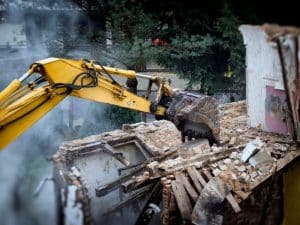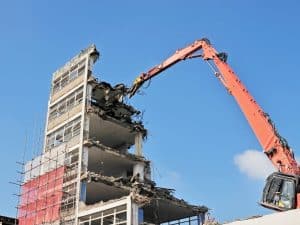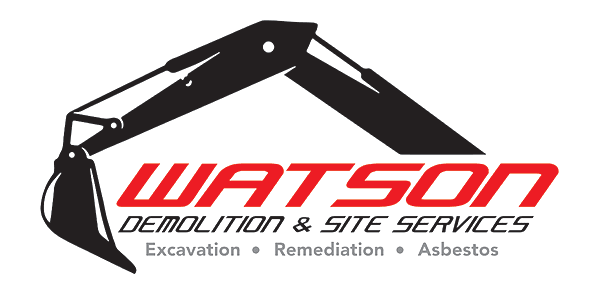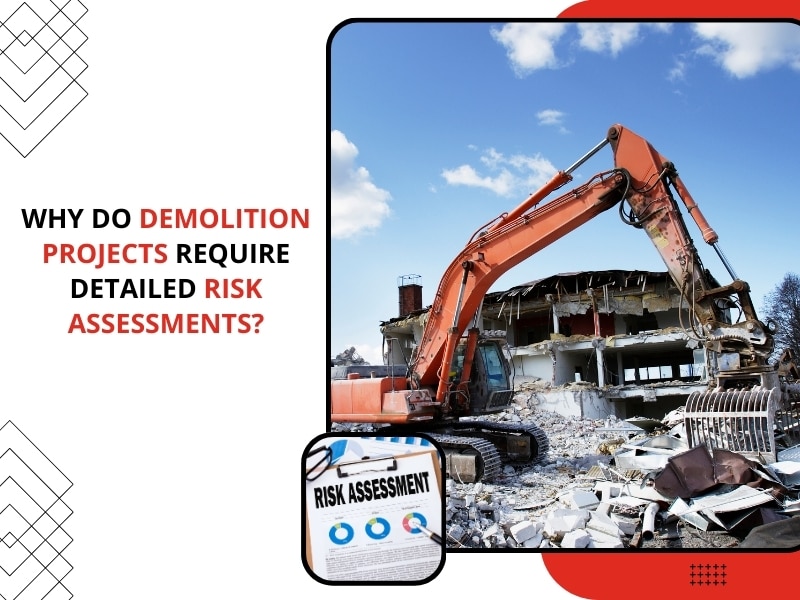Demolition projects, whether for residential, commercial, or industrial sites, are inherently risky due to their complexity and potential dangers. A detailed demolition risk assessment is a crucial component in managing these risks effectively. This process ensures that safety standards are met, hazards are identified, and the project runs smoothly. This article explores why detailed risk assessments are essential in demolition projects and how they contribute to the safety, efficiency, and success of each job.
What is a risk assessment in demolition projects?
A risk assessment in demolition projects is a systematic process of identifying, evaluating, and controlling hazards to people, property, and the environment. It’s a critical part of planning before work begins, considering factors like structural integrity, hazardous materials, and site conditions. Tailored to each project, it accounts for the building’s complexity, its contents, the surrounding environment, and demolition methods, helping identify potential hazards and ensuring safety, efficiency, and legal compliance throughout the demolition process.
How can hazard assessments improve safety during demolition?
Hazard assessments are a vital tool for improving safety throughout demolition projects. By identifying potential hazards before work begins, these evaluations help ensure the safety of workers and the general public. Some of the ways hazard evaluations contribute to safety include:
- Identifying unsafe practices: Early identification of potentially dangerous methods and practices can prevent accidents.
- Setting safety standards: Establishing clear safety guidelines ensures everyone on the site is aware of what’s expected.
- Preparing for emergencies: hazard assessments help develop emergency plans in case of accidents or unforeseen events.
- Controlling hazardous materials: Hazard assessments allow for the safe management and removal of dangerous materials like asbestos.
What hazards are identified during a demolition hazard assessment?
A comprehensive risk assessment and demolition planning identifies a wide range of potential hazards on a demolition site. Some common hazards include:
- Structural collapse: The risk of building sections collapsing unexpectedly is a significant concern during demolition.
- Falling debris: Hazardous materials or pieces of building structures can threaten workers and passers-by.
- Asbestos and hazardous materials: Old buildings may contain substances like asbestos, lead, and mould, so specific handling protocols are needed.
- Exposure to toxic fumes: Dust and fumes from materials can harm workers’ health if not managed.
- Electrical hazards: Exposed wires or damaged electrical systems pose electrocution or fire risks.

How does a detailed hazard assessment help in managing asbestos and hazardous materials?
Managing hazardous materials is one of the most critical aspects of demolition projects, especially for older buildings. A detailed risk assessment helps in:
- Identifying asbestos: Asbestos is a common material in older buildings. A risk assessment ensures it is recognised and removed safely before demolition starts.
- Establishing removal protocols: The evaluations guide the development of safe removal and disposal practices to prevent contamination and exposure.
- Ensuring proper containment: Risk assessments include strategies to prevent asbestos fibres from being released into the air during demolition.
- Compliance with regulations: A thorough evaluation ensures the project complies with safety regulations related to hazardous materials handling.
What are the legal and regulatory requirements for demolition risk assessments?
In Australia, demolition projects are subject to strict legal and regulatory requirements. These regulations are designed to protect the safety of workers, the public, and the environment. The key legal considerations include:
- WHS regulation: The Work Health and Safety Act 2011 requires that risks be appropriately assessed and appropriate control measures be put in place to protect workers.
- Environmental protection regulations: Address the management of hazardous waste, noise pollution, and dust emissions during demolition.
- Asbestos management regulations: Demolition companies must comply with stringent regulations when dealing with asbestos, including conducting risk evaluations and taking necessary precautions.
- Local council approvals: Specific requirements may vary depending on the location, and councils often require detailed risk evaluations before issuing demolition permits.
Why should commercial demolition projects prioritise hazard assessment?
Commercial demolition projects, due to their scale and complexity, require particular attention when it comes to risk management. Prioritising a detailed risk assessment for these projects provides numerous benefits:
- Large-scale operations: The size of commercial buildings increases accident risks, necessitating thorough assessments.
- Complex structures: Multiple floors and systems require careful planning for safe demolition.
- Public safety: Located in busy areas, commercial buildings must ensure public safety.
- Compliance: Detailed risk assessments ensure adherence to high regulatory standards for demolition projects.

By prioritising risk and structural assessments, commercial demolition projects can proceed smoothly, reducing risk to workers and the public.
What role does hazard assessment play in protecting workers and the public?
A well-conducted risk assessment plays a pivotal role in protecting both workers and the public during demolition work. Here’s how:
- Worker safety: Identifying potential risks ensures workers are trained and equipped to handle site hazards.
- Public safety: A risk assessment includes measures to protect pedestrians and nearby residents from dangers like falling debris or dust exposure.
- Emergency preparedness: It helps develop response plans, ensuring quick and effective action in case of incidents.
- Health protection: Identifying health risks, like toxic material exposure, ensures necessary safety measures are in place for all involved.
How can detailed hazard assessment prevent delays and cost overruns in demolition projects?
While risk assessments are often seen as an upfront cost, they can actually save money and prevent delays in the long run by:
- Preventing accidents: Fewer accidents lead to fewer stoppages, helping the project stay on schedule.
- Identifying potential delays early: Risk assessments highlight issues, like hazardous materials, allowing early intervention.
- Optimising resource allocation: Understanding risks enables more efficient resource use, reducing unnecessary costs.
- Avoiding legal issues: Risk assessments ensure compliance with regulations, preventing costly fines and legal problems.
Conclusion
A detailed risk assessment is a crucial step in any demolition project. By identifying hazards, managing hazardous materials, and complying with legal requirements, these assessments ensure that demolition projects are carried out safely and efficiently. Commercial projects alike benefit from risk assessments, which, when conducted by professional commercial demolition contractors, not only protect workers and the public but also prevent delays and cost overruns.
The importance of risk assessments in demolition
For expert demolition, excavation, and site preparation services, Watson Demolition & Site Services offers a comprehensive range of services across Newcastle, Hunter Valley, Sydney, and the Central Coast. Whether it’s a small residential job or a large commercial project, their team brings years of experience, strict safety protocols, and a commitment to customer satisfaction. Contact Watson Demolition & Site Services today for a free consultation and quote to discuss your project needs.

